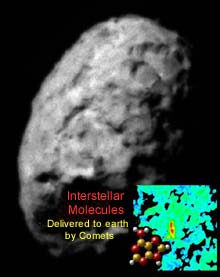Astrophysicists observe anomalies in makeup of interplanetary dust particle

A photo of the nucleus of comet Wild-2 observed by the STARDUST spacecraft Jan. 2, 2004 (image courtesty of NASA-JPL). Inset (lower right) is a secondary image (green/blue) of an interplanetary dust particle (IDP) with a 15 nitrogen-enriched and 13 carbon-depleted (red/yellow) "hotspot" containing similar atomic interstellar molecules.The adenine molecule (N5C5H5) is one possible carrier of the 13 carbon and 15 nitrogen anomalies. Cometary IDPs were likely a major source of organic matter accreted by the prebiotic earth. <br>
Scientists from Lawrence Livermore National Laboratory and Washington University have seen carbon and nitrogen anomalies on a particle of interplanetary dust that provides a clue as to how interstellar organic matter was incorporated into the solar system.
Interplanetary dust particles (IDPs) gathered from the Earth’s stratosphere are complex collections of primitive solar system material and carry various isotopic anomalies. Using an ion microprobe that allows isotopic imaging at a scale of 100 nanometers, the astrophysicists conducted simultaneous carbon and nitrogen isotopic imaging measurements of the IDP, nicknamed Benavente. They noticed that the isotope carbon 13 decreased while nitrogen 15 increased in Benavente.
The results appear in the Feb. 27 issue of the journal Science.
Interstellar molecular clouds are the principal formation sites of organic matter in the Milky Way. A variety of simple molecules are produced in dense cold clouds. At such low temperatures, where the difference in chemical binding energy exceeds thermal energy, mass fractionation produces molecules with isotopic ratios that can be very different from molecules found on Earth.
These anomalies may provide a fingerprint for how abiotic interstellar organic matter was incorporated into the solar system.
The authors concluded that the observation of correlated carbon and nitrogen anomalies establishes that IDPs contain heteroatomic organic compounds of presolar interstellar origins that are more complex than the simple compounds implied by earlier measurements. During the prebiotic period, Earth may have accreted as much as a centimeter of abiotic carbonaceous matter every million years, much of it settling to the surface within small, high-surface-area IDPs. “This constant flux of particulate organic matter continues to be delivered to the surface of terrestrial planets today and includes hetero-atomic interstellar molecules such as those found in Benavente. It is not unreasonable to speculate that heteroatomic interstellar molecular matter may be relevant to the origins of life on earth” said John Bradley, director of Livermore’s Institute for Geophysics and Planetary Physics and one of the authors of the paper. Other Livermore authors include Zurong Dai, Sasa Bajt and Giles Graham.
Founded in 1952, Lawrence Livermore National Laboratory is a national security laboratory, with a mission to ensure national security and apply science and technology to the important issues of our time. Lawrence Livermore National Laboratory is managed by the University of California for the U.S. Department of Energy’s National Nuclear Security Administration.
Media Contact
More Information:
http://www.llnl.gov/llnl/06news/NewsReleases/2004/NR-04-02-15.htmlAll latest news from the category: Physics and Astronomy
This area deals with the fundamental laws and building blocks of nature and how they interact, the properties and the behavior of matter, and research into space and time and their structures.
innovations-report provides in-depth reports and articles on subjects such as astrophysics, laser technologies, nuclear, quantum, particle and solid-state physics, nanotechnologies, planetary research and findings (Mars, Venus) and developments related to the Hubble Telescope.
Newest articles

First-of-its-kind study uses remote sensing to monitor plastic debris in rivers and lakes
Remote sensing creates a cost-effective solution to monitoring plastic pollution. A first-of-its-kind study from researchers at the University of Minnesota Twin Cities shows how remote sensing can help monitor and…

Laser-based artificial neuron mimics nerve cell functions at lightning speed
With a processing speed a billion times faster than nature, chip-based laser neuron could help advance AI tasks such as pattern recognition and sequence prediction. Researchers have developed a laser-based…

Optimising the processing of plastic waste
Just one look in the yellow bin reveals a colourful jumble of different types of plastic. However, the purer and more uniform plastic waste is, the easier it is to…


